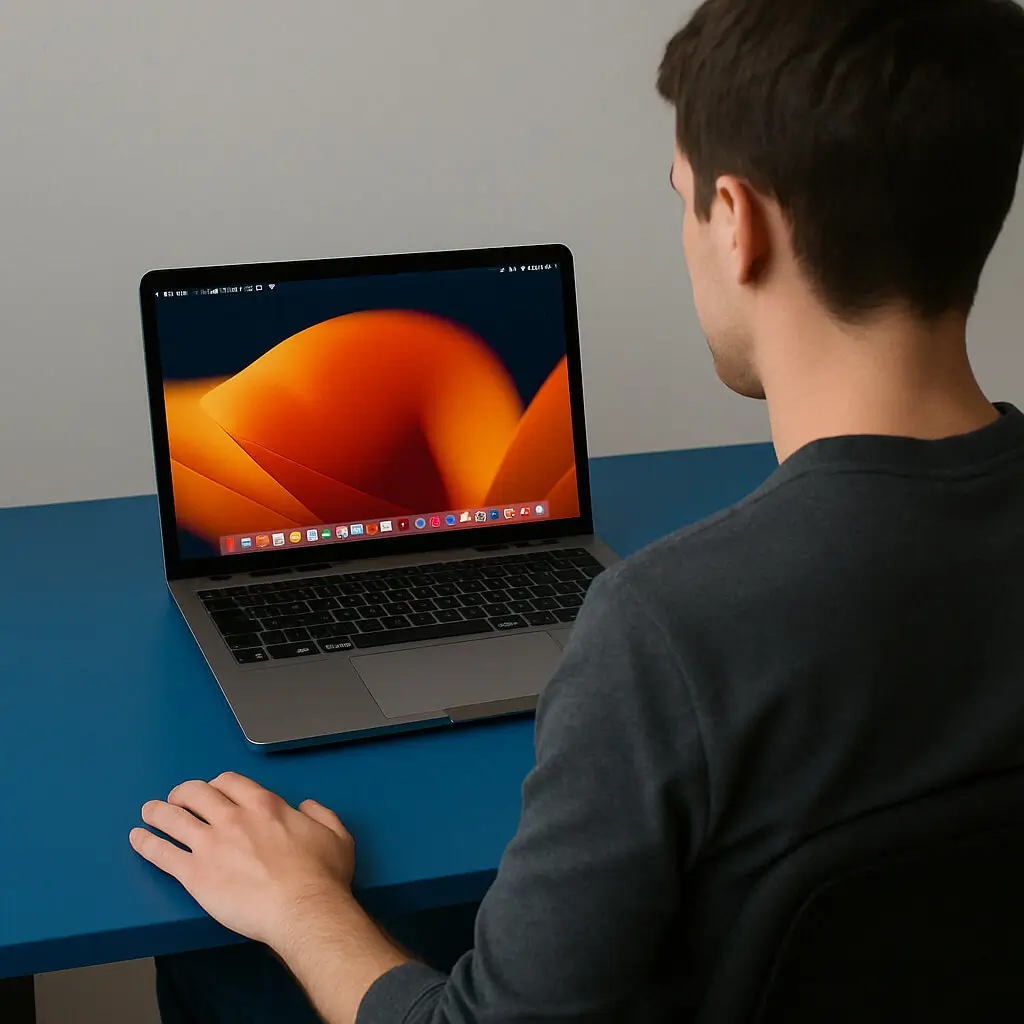The Power and Promise of High-End Computing: Why Premium Matters
In today’s increasingly digital world, the line between adequate and exceptional computing experiences grows more distinct with each technological advancement. The image of a professional working on a sleek MacBook with its vibrant display represents not just a piece of technology, but a gateway to possibility, efficiency, and creative expression. High-end computers and laptops have transformed from luxury items to essential tools for many professionals across diverse fields. This comprehensive exploration examines why premium computing matters and how it can fundamentally transform both work and creative endeavors.
Performance That Responds to Your Ambition
The heart of any high-end computer lies in its processing capabilities. Premium machines feature cutting-edge processors—whether Apple’s M-series chips, Intel’s latest Core i9, or AMD’s Ryzen 9 processors—that deliver computational power measured not just in raw speed but in multitasking capacity. This power translates into real-world performance that adapts to increasingly demanding software requirements.
For creative professionals working with 4K or even 8K video editing, complex audio production, or large-scale photographic projects, this processing headroom isn’t optional—it’s essential. High-end computers handle these tasks with a fluidity that prevents the all-too-familiar frustration of waiting for progress bars or, worse, system crashes mid-project. When deadlines loom, the difference between a machine that struggles and one that excels becomes acutely apparent.
The performance advantage extends beyond creative work. Data scientists analyzing large datasets, developers compiling complex code, and financial professionals running sophisticated models all benefit from systems that minimize wait times and maximize productivity. The value proposition becomes clear: when your time is valuable, investing in tools that optimize that time makes economic sense.
Memory and Storage: The Foundation of Smooth Operation
High-end computing isn’t solely about processor speed. Premium machines typically offer generous RAM configurations—often 16GB, 32GB, or even 64GB in professional workstations. This abundance of memory allows for seamless multitasking across resource-intensive applications without the system slowing to a crawl.
Similarly, storage solutions in premium computers prioritize both capacity and speed. Solid-state drives (SSDs) have become standard, with high-end models offering multi-terabyte capacities and blazing-fast read/write speeds. The practical benefit is tangible: applications launch instantly, large files open without delay, and system operations remain responsive regardless of workload.
For professionals working with large media libraries, architectural plans, or software development environments, this combination of abundant, high-speed memory and storage eliminates bottlenecks that would otherwise interrupt creative flow or analytical thinking.
Build Quality That Stands the Test of Time
Premium computers represent a philosophy of craftsmanship that extends beyond the internal components. The aluminum unibody construction seen in high-end laptops like the MacBook in our image exemplifies this approach. These machines are precision-engineered with tight tolerances, quality materials, and thoughtful design that elevates them from mere tools to reliable companions.
This superior construction manifests in numerous ways: hinges that remain stable after thousands of cycles, keyboards that maintain consistent feel, and chassis that resist flexing and damage. The premium materials—whether aluminum, carbon fiber, or magnesium alloys—contribute to devices that maintain their structural integrity and appearance far longer than their budget counterparts.
The environmental and economic implications are significant. Longer-lasting devices mean fewer replacements, reducing both electronic waste and the total cost of ownership over time. A high-end laptop might command twice the price of a budget alternative but could easily last three times as long while maintaining performance that remains adequate for evolving software demands.
Displays That Transform Visual Work
The display technology in premium computers represents one of their most visible advantages. The vibrant, color-accurate screens found in high-end machines deliver visual experiences that budget displays simply cannot match. Apple’s Liquid Retina XDR displays, Dell’s PremierColor panels, and similar technologies from other manufacturers offer wide color gamuts, high brightness levels, and precise calibration that make them suitable for color-critical work.
For photographers, graphic designers, video editors, and digital artists, these displays aren’t just pleasing—they’re essential tools that provide an accurate representation of their work. The ability to trust what you see on screen translates into fewer surprises when projects move to print or broadcast, reducing costly revisions and preserving creative intent.
Even for those whose work isn’t explicitly visual, high-resolution displays reduce eye strain during long working sessions and make text crisper and more readable. The enhanced visual experience contributes to both productivity and enjoyment, making the computer less of a utility and more of an environment where ideas flourish.
Thermal Management and Sustained Performance
One often overlooked advantage of premium computing hardware is sophisticated thermal management. High-end laptops and desktops incorporate advanced cooling systems—whether through vapor chambers, multiple heat pipes, or intelligently controlled fan systems—that allow processors to maintain higher performance levels for extended periods.
This sustained performance capability separates truly premium machines from those that might offer impressive benchmark numbers but throttle severely under extended workloads. For professionals engaged in lengthy rendering tasks, complex compilations, or extended editing sessions, the ability to maintain performance over hours rather than minutes can be the difference between meeting or missing crucial deadlines.
The superior thermal solutions also contribute to system longevity, as components operating at lower temperatures typically enjoy extended operational lifespans. This represents another aspect of the premium computing philosophy: designing not just for immediate impressions but for sustained excellence over years of use.
Ecosystem Integration and Software Optimization
Premium computers often exist within carefully designed ecosystems that enhance their capabilities. Apple’s integration between macOS and its hardware creates an experience where operations feel fluid and intuitive. Similarly, Microsoft’s Surface line demonstrates the advantages of tight hardware-software integration on the Windows platform.
This harmony extends beyond the operating system to applications optimized for specific hardware. Creative software from Adobe, Autodesk, and others often performs better on premium hardware not just because of raw specifications, but because of specific optimizations for high-end systems. The result is a computing experience that feels cohesive rather than cobbled together—where software and hardware collaborate rather than compete.
For professionals working across multiple devices, the ecosystem advantages multiply. The ability to seamlessly transition work between devices, share clipboards, or continue calls without interruption creates workflow advantages that transcend individual device specifications. This interconnectedness represents a productivity multiplier that justifies the premium investment for many professionals.
Security and Privacy Features
High-end computers typically incorporate advanced security features that protect both the device and the valuable data it contains. Hardware-level security elements like Apple’s T2 security chip or Microsoft’s Pluton processor provide protection that software-only solutions cannot match. These systems handle encryption, secure boot processes, and authentication in ways that significantly reduce vulnerability to sophisticated attacks.
For professionals handling sensitive client information, proprietary designs, or confidential business data, these security advantages provide peace of mind that budget alternatives rarely offer. The investment in premium hardware includes an investment in data protection that may prove invaluable in the event of theft or targeted attacks.
The Peripheral Experience
Premium computing extends beyond the primary device to the quality of input and output peripherals. High-end laptops typically feature superior trackpads with precise tracking and haptic feedback, keyboards with optimized key travel and tactile response, and audio systems that deliver clear sound for both communication and media consumption.
These seemingly minor details accumulate into a significantly enhanced user experience. When interaction with a device feels natural and responsive, cognitive load decreases and focus shifts from the tool to the task at hand. For professionals spending hours daily with their devices, these refinements contribute meaningfully to productivity and satisfaction.
The True Cost Calculation
The financial equation of premium computing requires looking beyond the initial purchase price to the total cost of ownership. Several factors influence this calculation:
- Depreciation rate: High-end computers typically retain value better than budget alternatives, resulting in higher resale values when upgrading.
- Productive lifespan: Premium machines often remain viable for professional work significantly longer due to more generous initial specifications and better build quality.
- Downtime costs: The reliability advantage of premium hardware translates into fewer failures and less productivity loss during critical periods.
- Efficiency gains: Faster performance on daily tasks accumulates into significant time savings over months and years of use.
When these factors are properly weighted, many professionals discover that premium computers represent not an extravagance but a rational investment in their professional capabilities. The seemingly high initial cost distributes across years of productive use, often resulting in a lower effective monthly cost than budget alternatives requiring more frequent replacement.
Finding Your Balance
Despite the advantages of premium computing, not every professional requires the absolute pinnacle of available technology. The key is matching investment to specific needs while avoiding false economies that lead to frustration and premature obsolescence.
For a professional photographer processing thousands of high-resolution RAW images monthly, investing in a high-end system with exceptional color accuracy and processing power makes economic sense. For a writer whose work primarily involves text, the same level of investment might be unnecessary, though considerations like keyboard quality and display legibility remain relevant.
The wisest approach involves honest assessment of computational needs, recognition of which specifications truly matter for specific workflows, and investment focused on those areas rather than pursuing premium features indiscriminately.
Conclusion: Beyond Status to Substance
The quiet elegance of premium computing isn’t fundamentally about status or showing off—it’s about removing friction between vision and execution. In a world where digital tools mediate so much of our creative and professional output, investing in quality means investing in potential.
The professional in our image, focused intently on their MacBook’s vibrant display, isn’t merely using a computer—they’re engaging with a tool specifically designed to fade into the background while amplifying their capabilities. This relationship between human and technology represents the true promise of premium computing: not to draw attention to itself, but to expand what’s possible through seamless, reliable performance.
For those whose livelihoods depend on digital tools, high-end computers aren’t luxury items but essential instruments that pay dividends through enhanced productivity, reduced frustration, and expanded creative possibilities. In this context, premium isn’t about excess—it’s about excellence sustained daily across years of professional use.











